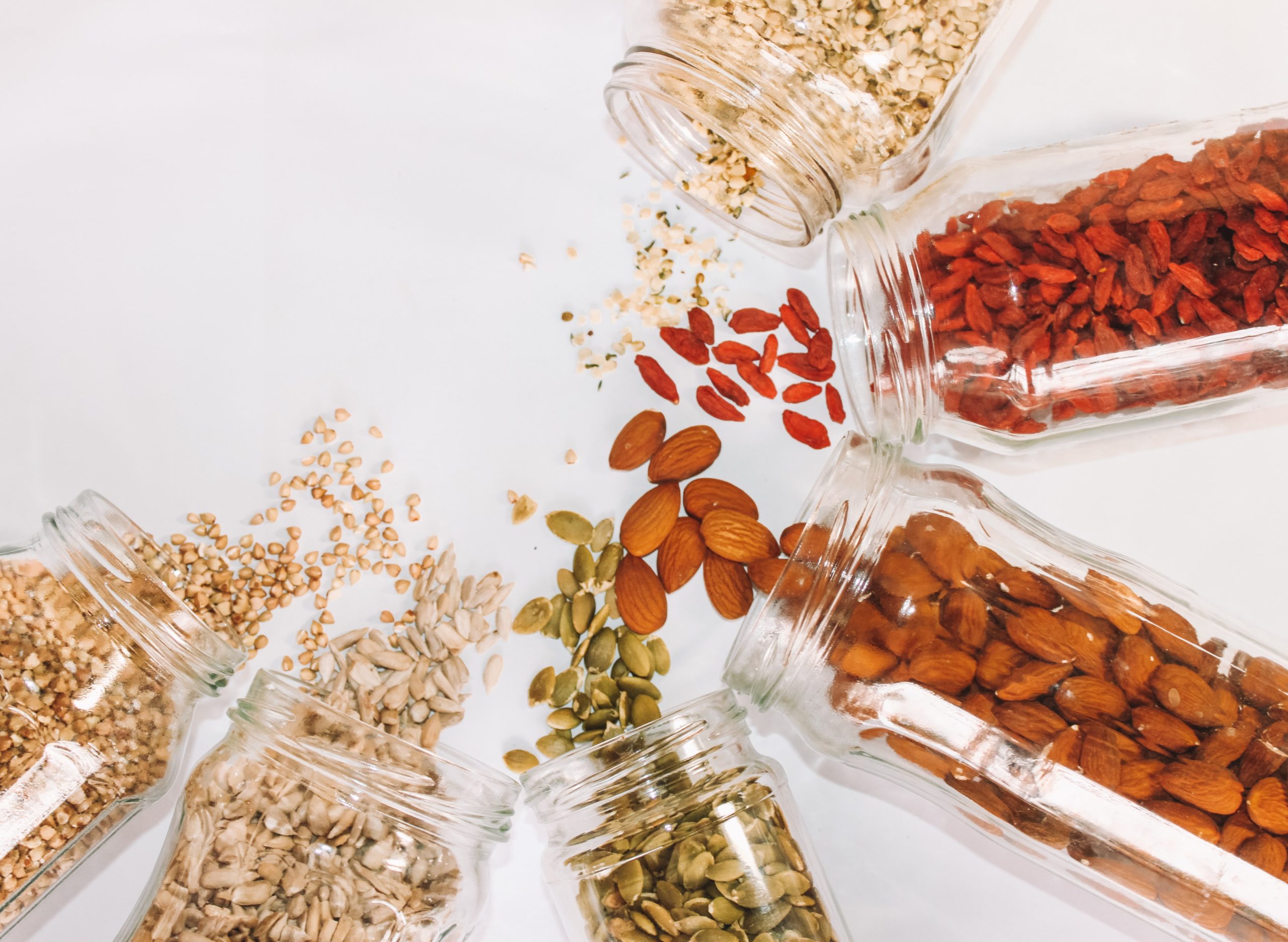Cycle Tracking, Seed Cycling, and Hormonal Balance. Oh my!
We will discuss seed cycling and hormone balance. We will break down the main hormones found in your body and why hormonal balance is so important. Also, we will briefly discuss some health benefits of each seed. Seed cycling gives us another tool for hormonal regulation but it will not solve all of your problems.
However, it will better connect you to your menstrual cycle, and that alone is priceless.
Knowing where you’re at in your cycle is like peering into the upcoming month. You will better understand where your energy levels will be. This means when you suddenly start to crave more time alone and feel lethargic, you won’t be so surprised.
With this understanding, it’s easier to find compassion for yourself. Because it’s not personal, it’s biological.
A great way to begin tracking your monthly cycle is with an app like Flo. There is a free option and a premium option. Flo offers insights and articles so you never feel alone. There are many apps out there, so find what works best for you.
If you’d like to read more empowering literature on the topic, Wild Power by Alexandra Pope and Sjanie Hugo Wurlitzer is a wonderful resource.
Hormones and Your Cycle
Your body sends messages through your bloodstream to organs and tissues using chemical messengers, known as hormones. They are essential for many of the body’s processes like reproduction, metabolism, development, and even mood (1).
The two female “sex hormones” are estrogen and progesterone. These are also present in males, but in a far lower quantity and with different functions than in females. They are called “sex hormones” because these two direct the menstrual cycle.
The Four Main Hormones in the Reproductive Cycle:
- Estrogen
- Progesterone
- Testosterone
- Follicle Stimulating Hormone
Testosterone in women is vital for muscle development, mental cognition, libido, and mood(19). It has similar roles in males and females.
The follicle-stimulating hormone (FSH) is responsible for triggering ovulation in women. In males, it helps with sperm production.
Symptoms of Hormonal Imbalance:
Hormonal balance is a delicate dance. It only takes a small shift to create large changes in your body. (1) Here is a list of potential side effects of a hormonal imbalance(15).
Please note that this list is general and not a diagnosis. Keep in mind the root of holistic medicine; symptoms are symptoms and they only lead us closer to the root cause(s).
- weight gain or sudden weight loss
- fatigue
- muscle weakness
- increased or decreased heart rate
- increased sensitivity to cold or heat
- constipation
- frequent urination
- increased hunger or thirst
- decreased sex drive
- depression
- nervousness, anxiety, or irritability
- blurred vision
- infertility
- thinning hair or fine, brittle hair
- dry skin
- heavy or irregular periods
- excessive hair on the face, chin, or other parts of the body
- acne on the face, chest, or upper back
- skin tags
- vaginal dryness
- night sweats
- headaches
Maybe you suffer from some of these symptoms of hormonal imbalance. Whether you’ve struggled for a while or it’s a recent occurrence, learning more about your hormones will always help. Seed cycling is an additional way to get in touch with yourself and your cycle.
With that said, seed cycling isn’t meant to be a prescription or a replacement for treatment from a medical professional. If you’re already being treated, please speak with your healthcare provider before implementing something new.
The Female Monthly Cycle
Your monthly cycle starts on the first day of your period and is divided by ovulation into two main phases(13). Those are the follicular and luteal phases. Think of these as the waxing and waning phases of the moon. The average cycle length is 28 days, give or take 7 days.
During the first phase, the follicular phase, the hormone estrogen is rising. It is the first 14 to 16 days of your cycle. It begins the first day of your period and ends on ovulation day. Energy is typically highest in this phase because of higher levels of estrogen.
Right after ovulation, you enter the luteal phase of your cycle. During this phase, progesterone is rising to thicken the uterine walls in preparation for potential implantation. Luteal begins at the end of ovulation and ends on the first day of menstruation.
Energy begins to wane after ovulation due to a decrease in estrogen and an increase in progesterone.
If you want a full breakdown of what happens hormonally at each part of your cycle, read this article from Very Well Health. It’s informative and approachable with reliable sourcing.
What seeds to take and when?
Seed cycling or seed rotation is the consumption of four different types of seeds at the two parts of your monthly cycle. You take 1-2 TBS of each of the following according to where you are in your menstrual cycle. Freshly ground is said to be easier for nutrient absorption.
Follicular:
- Flax Seeds
- Pumpkin Seeds
Luteal:
- Sesame Seeds
- Sunflower Seeds
How Seed Cycling Works with Your Hormones
In the first phase, the follicular, phytoestrogens in flax mimic estrogen in the body. This allows you to either increase or decrease estrogen levels. The zinc in pumpkin seeds is meant to encourage progesterone to prepare the body for the upcoming luteal phase.
For the second half of your cycle, the luteal phase, sesame seeds contain a type of polyphenol that inhibits estrogen levels from rising. Then, the high levels of vitamin E in sunflower seeds are meant to boost progesterone(18).
The Benefits of Seed Cycling for Hormone Regulation:
- Hormone Regulation (Though this isn’t to be used instead of advice or prescriptions from your health care provider)
- A deeper understanding of your moon cycle
- Consistent intake of healthy fats + nutrients from functional food
- A new habit of self-care
- The energetic investment of taking the time to care for your body
Some Nutritional Benefits of Each Seed
Flaxseed
Flaxseed is known as a functional food because it can have physiological benefits and can be beneficial in preventing disease. According to a medical article on PubMed Central, this is due to flaxseed being the “best omega 3 fatty acid source to the non-fish eaters.” (7)
Omega-3s are also extremely important during pregnancy, both for fetal development and when the infant is breastfed. A medical journal reports they “could play a positive role in the prevention of menstrual syndrome and postmenopausal hot flushes.” (9)
Furthermore, just 100g of flax provides over 90 percent of the daily recommended value of magnesium, phosphorus, and thiamine.
Pumpkin
Pumpkin seeds contain essential fatty acids, reduce cholesterol, and are a rich source of protein, fiber, and essential minerals. Just 100g of these seeds contain more than 20% percent of your daily requirement of iron, zinc, manganese, magnesium, niacin, and phosphorus.
In this small portion of seeds, there’s 214 percent of your DV of manganese, an essential trace mineral(3)! This mineral is essential for important body processes like absorbing nutrients and producing digestive enzymes. It helps strengthen the immune system, is involved in the formation of bone mass, and helps balance hormones(4).
Magnesium-rich foods help reduce bloating, which is a common experience during ovulation and the entire luteal phase of your cycle.
Sesame Seeds
Sesame seeds are anti-inflammatory, meaning they decrease inflammation in the body systems(11). They fight infections with their antioxidant and antibacterial properties. The high amounts of magnesium in these magic seeds may help lower blood pressure(12).
It’s important to note that sesame seeds do contain anti-nutrients so an overconsumption of them can stifle nutrient absorption. Soaking the seeds overnight in filtered water can help decrease these properties in the seeds.
Sunflower Seeds
Amazingly enough, just 100 grams of sunflower seed kernels contain 234 percent of RDI of Vitamin E. This seed is also high in the minerals iron, magnesium, manganese, phosphorus, and zinc.
Vitamin E is an antioxidant, meaning it has properties that protect your cells from the negative effects of free radicals. This nutrient is essential to reproductive health, vision, and the health of your skin, brain, and blood.
Keep in mind that it’s better to consume naturally occurring vitamin E in foods rather than in supplements because the absorption isn’t the same(14).
How to Integrate Seeds
- Add to smoothies
- Add to salad
- Add to soups
- Add to breading or crusting recipes
- Make breakfast bars
- Sunflower Seed Butter
- Roasted Pumpkin Seeds
What are some ways you like to eat your seeds? Let us know in the comments.
Thank you for reading and we hope this was helpful. If you want a community to learn with, join us on Facebook at Holistically Healthy Women.
And if you are ready for more intimate coaching, book a call with me today.

